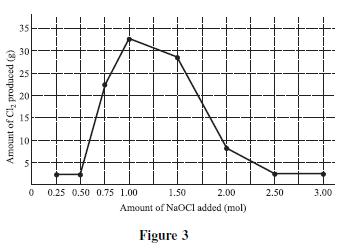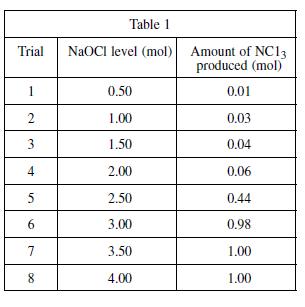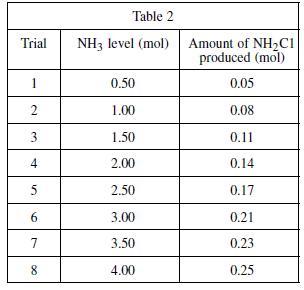The production of a certain plastic calls for a mixture of bleach and ammonia. However, the presence
Question:
The production of a certain plastic calls for a mixture of bleach and ammonia. However, the presence of chlorine gas is highly undesirable. Based on the results of Experiments 1, 2, and 3, which of the following specifications should be chosen?
A. Minimum of 2.00 mol NaOCl and maximum 1.00 mol NH3
B. Minimum of 1.00 mol NaOCl and maximum 1.00 mol NH3
C. Exactly of 1.50 mol NH3 and exactly 1.50 mol NaOCl
D. Exactly of 1.00 mol NH3 and exactly 1.50 mol NaOCl
Experiment 1
A known by-product of the reaction of bleach and ammonia is chlorine gas (Cl2). Chlorine gas has an intensely disagreeable suffocating odor, and is very poisonous. To determine the quantities of bleach and ammonia that, when mixed together, produce chlorine gas, a varying quantity of bleach was added to eight different ammonia–water solutions and the resulting chlorine gas from each mixture was collected and measured. A solution of 1.0 mole (mol) of NH3 in 1 kg of water was used in each trial. A certain quantity of NaOCl was added to each of the solutions; the amount added was gradually increased for each trial. The amount of chlorine gas produced in each trial was recorded and graphed in Figure 1.

Experiment 2
Another known by-product of the reaction of bleach and ammonia is nitrogen trichloride (NCl3). Nitrogen trichloride is a yellow, oily, pungent-smelling liquid, often found as a by-product of chemical reactions between nitrogencontaining compounds and chlorine. It is highly explosive. To determine the quantities of bleach and ammonia that, when mixed together, produce NCl3, again a varying quantity of bleach was added to eight different ammonia–water solutions and the resulting NCl3 from each mixture was measured. A solution of 1.0 mole (mol) of NH3 in 1 kg of water was used in each trial. A certain quantity of NaOCl was added to each solution; the quantity added was gradually increased for each trial. The amount of nitrogen trichloride produced in each trial was recorded in see Table 1.

Experiment 3
In yet another reaction, bleach and ammonia combined under certain conditions produce a compound known as chloramine. Chloramine (NH2Cl) is a toxic substance commonly used in low concentrations as a disinfectant in municipal water systems as an alternative to chlorination. To determine the mixture of bleach and ammonia at which NH2Cl is produced, a varying amount of ammonia was added to eight different bleach–water solutions and the resulting chlorine gas from each mixture was collected and measured. A solution of 1.0 mole (mol) of NaOCl in 1 kg of water was used in each trial. A certain quantity of NH3 was added to each solution; the quantity of ammonia added was gradually increased for each trial. The amount of chloramine produced in each trial was recorded in Table 2.

Step by Step Answer:






